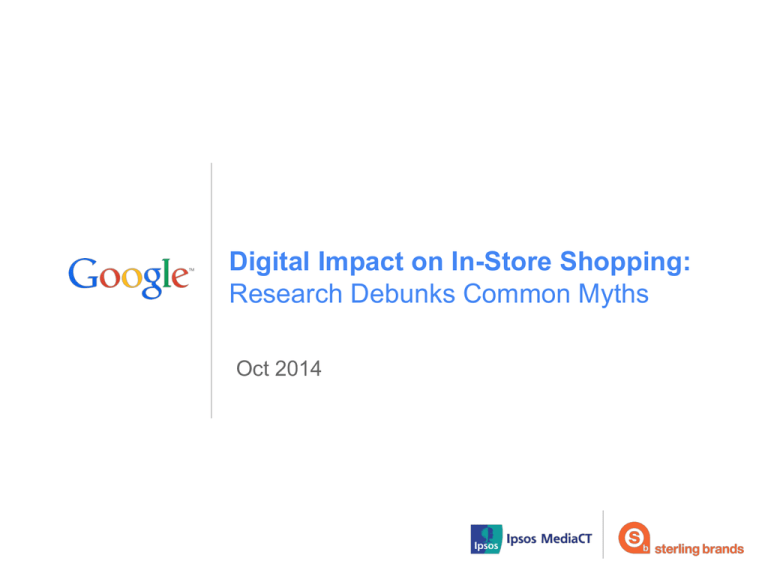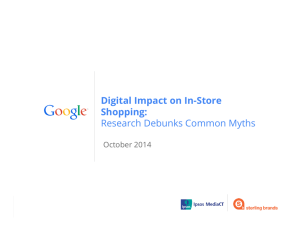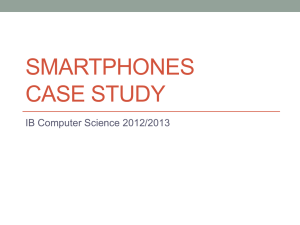
Digital Impact on In-Store Shopping:
Research Debunks Common Myths
Oct 2014
BACKGROUND
We all know that the spread of smartphones and access to
online information has changed the way we shop in physical
stores — or, at least we think we know.
But how much has it really changed?
Will the online marketplace replace the store?
Will tomorrow’s consumers be so informed that the in-store shopping experience
won’t matter any longer? Is this the beginning of the end for physical stores?
To know how to act, stores need more information about constantly connected
consumers and how they really shop.
So Google did a little research and confirmed some accurate perceptions about the
impact of smartphones and online information on in-store shopping — and we also
discovered a few myths that need to be debunked.
RESEARCH METHODOLOGY
Google worked with Ipsos and Sterling Brands to explore
consumers’ in-store shopping behavior and expectations in 3 verticals:
1. Retail (apparel/accessories, appliances, home furnishings, sporting goods, home improvement)
2. Tech (mobile phone handsets, computer, consumer electronics)
3. CPG (food, home care, personal care, beauty care)
Sterling - Qualitative Insights
69 participants completed 3-day online journals in NJ
and TX March 12-14, 2014. Of which, 16 were invited
to participate in shopping tasks with a friend of their
choice March 18 & 20. Screening criteria:
Smartphone, tablet and computer users age 18-32,
mix of parents, non-parents, and genders1. Projective
thinkers2 who shop both online and in-store, use
tablet/smartphone for shopping, use the Internet to
research purchases at least 1x/week, and have
purchased 2 product categories within the last 2
months.
Sterling Brands is a leading brand strategy consultancy with expertise in
positioning, innovation and design. We believe that strong brands are built on
clarity of difference, so we conduct research to help brands uncover meaningful,
differentiated customer insights.
Ipsos Online Survey - Quantitative Insights
6,000 respondents (N=2,000 per vertical)
completed an online survey in May 2014.
Screening criteria: Smartphone users age 18-54.
Sole or shared purchase decision-makers who
have used the Internet to research any purchase
and purchased at least 2 product categories
within the past 6 months.
Ipsos MediaCT is the market research division within Ipsos that specializes in
reaching, engaging and more effectively understanding today’s digitally- driven
consumer in the fast moving media, content and technology space.
1. 25/75 split for age 18-25/26-32; 50/50 split for parent/non-parent; 56/44 split for female/male.
2. In this study, “projective thinkers” is defined as individuals who hold a creative job or creative hobbies and are early adopters or fast followers of new technology.
Projective thinkers were recruited because they tend to be leading edge shoppers.
WHAT WE GOT RIGHT
Today’s consumers are more informed than ever before.
They want information throughout the shopping process,
and this drives their use of smartphones and their
consumption of online information for shopping.
Stores that ignore this preference risk losing customers, but
opportunities exist for retailers who find ways to take
advantage of this behavior.
CONSUMERS PURSUE INFORMATION ALL THE TIME
– BEFORE, DURING, AND AFTER STORE VISITS
Shoppers look for information:
87%
79%
35%
Before visiting
a store
While visiting
a store
After visiting
a store
Base: Shopped At A Store And Looked For Information During Any Phase (n=4860).
Google/Ipsos Q. Listed below is the type of information that you looked for related to your [SUB-VERTICAL] purchases.
At which point(s) did you look for each type of information? Please select all that apply for each type of information.
Methodology Note: Respondents were screened on smartphone usage and purchase behavior
CONSUMERS USE A VARIETY OF ONLINE SOURCES,
ESPECIALLY SEARCH ENGINES AND MOBILE SITES/APPS
Consumers use the following online sources
for information on products/services:
75%
Search Engines
Online-only Retailer
sites/apps
71%
Website/Apps for Retailers
with Physical Stores
70%
Social Networking
websites/apps
39%
Online Video
websites/apps
36%
Coupon or Daily Deal
websites/apps
35%
Base: Looked for Information Using a Device (n=5176)
Google/Ipsos Q. Did you use the following websites or applications (“apps”) in the past 6 months for your [SUB-VERTICAL] purchases?
Think about any websites or apps you used before, during or after your purchases.
Methodology Note: Respondents were screened on smartphone usage and purchase behavior.
SHOPPERS FEEL FRUSTRATED BY THE
LACK OF INFORMATION IN STORES
2 in 3 shoppers who tried to find information
within a store say they didn't find all the info they needed
43%
41%
22%
were left
frustrated
more likely to shop
elsewhere
of them less
likely to buy from
the retailer
Base: Looked For Info In A Store (n=3839).
Google/Ipsos Q. Which of the following words and phrases, if any, describe how you felt when you did not find the information you were looking in-store?
Methodology Note: Respondents were screened on smartphone usage and purchase behavior
CONSUMERS TURN TO THEIR SMARTPHONES
IN-STORE TO FILL AN INFORMATION GAP
71%
of in-store shoppers who
use smartphones for online
research say their device
has become more important
to their in-store experience
Base: Made A Purchase In-Store And Use Devices To Gather Info (n=1974).
Google/Ipsos Q. How much more or less important has each device become in helping with your in-store shopping?
Methodology Note: Respondents were screened on smartphone usage and purchase behavior
MYTHS THAT NEEDED BUSTING
We were right about consumers’ desire for
information, but we didn’t have a clear picture of what
this could mean for brick and mortar stores.
The research shows that rather than marginalizing
the value of in-store shopping, smartphones and
online information offer an opportunity for stores to
enhance consumers’ shopping experience.
Myth #1
Search results only send consumers to
e-commerce sites.
Reality
Search results are a powerful way to drive
consumers to stores. Providing local
information, such as item availability at a
nearby store, local store hours, etc., fills in
information gaps that are keeping consumers
away from stores.
CONSUMERS AVOID STORES BECAUSE THEY LACK
INFORMATION ON LOCATION AND STOCK AVAILABILITY
1in 4
consumers who avoid
stores do so because of
limited awareness of nearby
stores or the risk of items not
being available
Base: Did Not Shop At A Store At All (n=885).
Googe/Ipsos Q. You indicated that you did not visit any stores related to your [SUB-VERTICAL] purchases in the past 6 months.
For which reason(s) did you not visit a store at all? Even if you indicated these answers earlier, please select them here, too.
Methodology Note: Respondents were screened on smartphone usage and purchase behavior
ONLINE INFORMATION IN SEARCH RESULTS OFTEN
SENDS CONSUMERS TO STORES
3 in 4
who find local
information in search results
helpful are
more likely to visit stores
Base: Used Search Engines and Consider Any Item At Least Somewhat Helpful (n=3842).
Googe/Ipsos Q. And, would having this information included within your search results make you...? (respondents evaluated local information in search results)
Methodology Note: Respondents were screened on smartphone usage and purchase behavior
ONLINE INFORMATION FILLS IN INFORMATION
GAPS AND MOTIVATES STORE VISITS
Shoppers would find this information
very/extremely helpful in search results:
75%
Price of item
at a nearby store
74%
Item is in stock
at nearby store
66%
Location of
closest store
with item in stock
63%
Details about local
stores (hours,
phone number)
59%
Map showing which
stores carry the
item searched for
56%
What else is available
at the store that carries
the items searched for
Base: Used Search Engines (n=3891).
Google/Ipsos Q. Earlier, you mentioned that you used search engines to gather information about your [SUB-VERTICAL] purchases. Below are types of
information that could be made available on the search engine results page in the future (thus minimizing the need for you to click through to another website).
How helpful would each of the following be if they were included within your search engine results?
Methodology Note: Respondents were screened on smartphone usage and purchase behavior
What brick and mortar stores can do
Physical stores can provide helpful information
online to drive consumers to stores.
Make sure to feature product availability, store
location, hours and your phone number in ads.
Plus, use local inventory ads to let shoppers know
that the product they’re searching for is in stock
nearby at your store. And, consumers can check
out other items you have available.
Myth #2
Once in-store consumers begin looking
at their smartphones, the store has
lost their attention.
Reality
Stores can grab consumers’ attention through
search results and a retailer’s mobile site or
app.
CONSUMERS LOOK AT COMPETITOR SITES –
BUT A GREATER PERCENTAGE LOOK AT SEARCH ENGINE
RESULTS AND THE RETAILER’S SITE/APP
42% of in-store consumers conduct
research online while in stores using:
64%
46%
30%
26%
Base: Looked For Info in A Store (n=3839); Base: Used Online Resources to Look For Information in A Store (n=1620)
Google/Ipsos Q. Thinking about all the information you looked for while in-store, how did you find the information, if at all?
Methodology Note: Respondents were screened on smartphone usage and purchase behavior
Search
engines
Retailer’s
site/app
A different retailer’s
site/app
Another type of site/app
(e.g., coupon review)
What brick and mortar stores can do
Optimize your search engine results and mobile website
or app.
Consumers are looking up information in stores —
and many are accessing search engines and the website
or app for the retailer whose store they are in.
Stores should optimize their online presence, including:
search results, website, app, and mobile ads to engage
consumers while they're in stores.
Myth #3
Online research has limited what
consumers expect from stores; they really
just go to stores to transact.
Reality
Consumers still visit stores for more than just
transactions, but they now expect more out
of any place they shop. They want informed,
customized experiences.
CONSUMERS USE STORES THROUGHOUT THE
PURCHASE PROCESS FOR MORE THAN JUST
TRANSACTIONS
69%
of consumers used physical stores for information
during different phases of the purchase process:
32%
33%
55%
Inspiration
Research
Purchase
Inspiration
The time when you
realized you wanted or
needed a particular
product(s).
Research
The time when you
actively looked and
researched your
purchase.
Purchase
The time when
you purchased the
product(s).
Base: Total Respondents
Google/Ipsos Q. Please think about how you looked for information for your [SUB-VERTICAL] purchases in the past 6 months.
During each of the following phases, which of the following did you use to find this information? Please select all that apply for each phase.
Methodology Note: Respondents were screened on smartphone usage and purchase behavior
14%
Post
Purchase
Post Purchase
Any behavior you may
have participated in after
you purchased your
product(s).
CONSUMERS PREFER STORES THAT OFFER
PERSONALIZED RECOMMENDATIONS AND COUPONS
Shoppers would be more likely to shop in stores that offer:
85%
Personalized coupons and exclusive
offers provided in stores
64%
Recommendations for specific
products to purchase
54%
Recommendations based on what
friends/family have purchased
Base: Total Respondents.
Google/Ipsos Q. There is information often available online, but not typically provided in stores. How much more likely would you be to shop from a specific
retailer in the future for [SUB-VERTICAL] purchases if it provided the following information in the store (via displays, self-help kiosks, sales associates)?
Methodology Note: Respondents were screened on smartphone usage and purchase behavior.
What brick and mortar stores can do
Brick and mortar stores can and should create
“smarter” store experiences.
Customized offers and recommendations
can be delivered right to consumers as they
search on their phone, or be integrated into the
in-store experience.
WHAT BRICK AND MORTAR STORES NEED TO DO
Online information and smartphones have changed consumer behavior. Consumers want
information throughout the shopping process, they seek it out online even while in a store, and
they expect more from retailers who want to win their business. But this doesn’t have to be a bad
thing.
Savvy retailers will take steps to satisfy consumers’ desire for smarter experiences:
Provide location and stock availability information online
Consumers are more likely to visit stores when they find information on things like product
availability and store location online. By providing this local information in advance, stores can
increase business and improve customer satisfaction.
Optimize your search engine results and website or app
When consumers use their smartphones in-store, they’re probably looking at search engine
results or the retailer’s own website/app. Take advantage of this by ensuring that you feature
relevant information in search results (e.g., location of nearby store with item in stock), have a
mobile optimized site and app, and have mobile ads to engage consumers.
Create “smarter” customized shopping experiences
Consumer expectations have gone up; they prefer stores that offer personalized experiences.
Smart retailers will take advantage of their online presence and in-store experience to deliver
coupons and recommendations that are customized to shoppers.
Digital Impact on In-Store Shopping:
Research Debunks Common Myths
© Copyright 2014 Google. All rights reserved. Google and the Google logo are registered trademarks of Google Inc.








